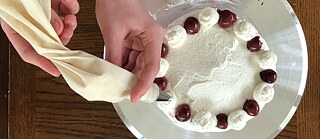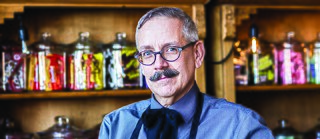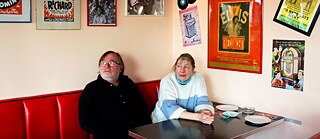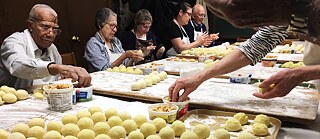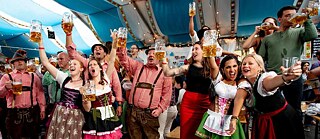Ein Traum aus Biskuit und Sahne
Getting to Know the Gateau
Es ist ein weitverbreitetes Missverständnis, dass ein German Chocolate Cake deutsch ist. Tatsächlich ist das Backwerk nach seinem Erfinder Samuel German benannt, einem US-amerikanischen Bäcker. Doch es gibt eine echte deutsche Torte, die in Deutschland und den USA gleichermaßen beliebt ist – die Schwarzwälder Kirschtorte.
Diese Folge anhören: Apple Music | Spotify | Download
Diese Folge stammt von Kate Sammer. Kate wurde im kalifornischen San Diego geboren, wo sie auch aufwuchs. An der Columbia University studierte sie Anthropologie mit Schwerpunkt auf ethnografischem Film und nicht-fiktionalem Video. Für diesen Podcast ist Kate nach Deutschland gereist und unterhielt sich mit Astrid Lehmann vom Schwarzwaldmuseum in Gutach, mit dem Besitzer in dritter Generation der Familienbrennerei Marder Edelbrand sowie der Inhaberin des Cafés und Souvenirgeschäfts Kuckucksnest. Das Foto zur Folge stammt von Nikki Out West und zeigt eine Schwarzwälder Torte.
Transkript
Kate Sammer: It’s a common misconception that German chocolate cake is, well, German.
In fact, the recipe is named after its inventor, Samuel German, who was an American baker that first developed it back in 1852. The story I’m going to tell you today, however, is about a real German cake — the Black Forest gateau or Schwarzwälder Kirschtorte.
In case you haven’t had the pleasure of trying a slice, let me break it down for you. Picture a triple-tier chocolate sponge cake saturated in cherry Schnapps; sandwiched between each layer is a cherry filling that’s also infused with alcohol. The cake’s surface is completely frosted with a boozy whipped cream, and its sides are decorated with a layer of chocolate bark. To add a final touch, the top is trimmed with a ring of cherries.
It’s a tasty cake, which is why it has garnered international praises as one of Germany’s most famous exports. Although it’s not certain who first wrote the recipe, the cake has been fully embraced by the Black Forest community as an essential part of their cultural identity. But what is it about this confectionary classic that specifically makes it a Black Forest cake? That’s what I was hoping to find out.
❡
Kate Sammer: Schwarzwald, or the Black Forest, is a mountainous region in the southwesternmost corner of Germany. It belongs to the German State of Baden-Württemberg and shares its borders with Switzerland and France. It’s because of this proximity to France that English references to the Black Forest dessert often use the terms ‘cake’ and ‘gateau’ interchangeably.
This is my first time visiting the Black Forest, and it’s unlike any mountain driving I’ve experienced. The roads are narrow, and incredibly steep, with switchbacks and winding turns. Even in the light of day, the Black Forest stays true to its name. The main road carves a single passage through the dense thickets. Massive fir and pine trees edge up against the pavements on both sides. Their branches converge overhead, forming a canopy of foliage that cloaks my route in shadow. The darkness is fractured by sunrays. Light flickers past my eyes as it slips through narrow gaps in the veil of leaves. Seeing the landscape first hand, I can understand why so many consider the dark chocolate coating on the Black Forest cake to be a tribute to these woods.
Every once in a while, the foliage thins, and I find myself cruising through patches of countryside. The air smells faintly of sawdust as I pass by a crew of workers hauling logs of wood into a truck bed. This region’s rugged terrain and severe weather made it one of the last parts of Germany to be developed. Still today, most economic activity in these far-flung rural settlements is tied to the natural environment.
Goats and cattle can be seen roaming freely along the edge of grassy valleys. They belong to dairy farms, which, among other things, produce local ‘Schwarzwaldmilch,’ a heavy cream that’s used in traditional recipes to make Black Forest cake frosting. Here in the clearings the atmosphere is serene, but a few kilometers pass, and I’m pulled back into the darkened woods.
Devoid of human activity, but teeming with an eerie liveliness, it’s not hard to imagine why this enchanted landscape set the backdrop for countless Brothers Grimm fairytales like Hansel and Gretel.
One legend in particular has led me here today. It’s been said that the cake’s cherry garnish was originally intended to resemble the ‘Bollenhut,’ a folkloric hat and gown traditionally worn here in the Black Forest. In search of answers, I’m visiting the Black Forest Open Air Museum in Gutach to ask about the Bollenhut and find out whether this cake connection is anything more than coincidence.
Astrid Lehmann: If you look at the Black Forest, at a map, you are here located right in the heart, and here’s our open air museum, we represent the entire Black Forest, over six hundred years of history. We have this uniqueness here with our traditions and customs, and we show to the visitors how was life for hundreds of years here in the Black Forest.
Kate Sammer: Astrid Lehmann works for visitor services here at the museum, where she’s arranged for me to meet a Bollenhut lady. If you’re not familiar with the Bollenhut, it’s a head to toe outfit — complete with mohair socks, a white puffy blouse, and a sequined black dress.
Astrid Lehmann: The Bollenhut folkloric dress, it’s very famous for its hat, which weighs up to 1.5 kilos and has 14 red balls for the unmarried ladies and 14 black balls for the married ladies. The funny thing, however, is that you only see 11 balls. Three are underneath to give volume. And the sizes of the pompons there are five different sizes, all regimented. They’re assembled in a cross really, but you can’t see because the pompon is so big, so you can’t see the cross.
Kate Sammer: This dress dates back to the 18th century, where it was worn for various religious services and folk festivals as part of the Lutheran church. The forest’s earliest settlers came here to establish monasteries, which is why much of the local culture is defined by religious tradition.
Astrid Lehmann: This Bollenhut folkloric dress is world famous, but it’s only original here where we’re standing in Gutach, in this village and two other villages. Only when you come from this village you are allowed wearing this folkloric dress, and only there it’s authentic.
Kate Sammer: The Black Forest’s Bollenhut belongs to a class of traditional German clothing known as Tracht. Tracht is unique in that each outfit can be worn only in specific regions of Germany, and it must comply with a set of strict rules for wear. The most widely recognized example of Tracht being the Bavarian dirndl and lederhosen. Historically, Tracht indicated a person’s economic, religious, or social status. But nowadays, it’s worn mainly to celebrate cultural diversity and show local pride.
Astrid Lehmann: Other villages have also their folkloric dresses, in the Black Forest we have up to 270 different folkloric dresses.
Kate Sammer: That’s a lot of folkloric dresses. And some even exist in different versions, like the Bollenhut, with its colors being either red or black — depending on the marital status of its wearer. However, it’s the red cap for the unmarried lady that has become emblematic of the Black Forest. Although it is only authentic to three villages, the Bollenhut’s popularity is widespread. It appears on the official logo for the Black Forest tourism board, and it’s a recurring theme in local art. It’s because of this fame has led many to speculate that the Black Forest cake itself was decorated to resemble that it, too, was wearing a Bollenhut. Now I realize, it feels odd to draw comparisons between folk wear and a cake, but the resemblance between the two is uncanny, so I had to ask.
Astrid Lehmann: There is this legend that the cake comes from the hat basically, but when actually there is no truth to it, I’m afraid.
Kate Sammer: Whether or not the cake was decorated to model the Bollenhut, the two sure look good together and have made quite the duo for Black Forest advertising.
Astrid seems to think the similarities are only a fluke, instead suggesting that the cake’s origin has more to do with the region’s outstanding reputation for private distilleries.
❡
Kate Sammer: In the 2,300-plus square miles that make up the Black Forest there are approximately 28,000 family-run distilleries. That’s the highest concentration of distilleries in the country and the second highest in the world — the leader being Scotland, just in case you were wondering. A variety of whisky and fruit brandies are produced here in the Black Forest, but it’s the Cherry Schnapps or Schwarzwälder Kirschwasser that’s made a name for itself as the region’s signature flavor. With an ample supply of kirsch and a little culinary ingenuity, the cake became a delicious new medium for the cherry beverage. To see the traditional methods of Kirsch production in operation, I’m visiting the Marder Edelbrand Distillery. Here, owner and third generation distiller, Stefan Marder, talks me through some of the specifics.
Stefan Marder: Schwarzwälder is a higher quality than only kirsch. You can call it ‘Kirsch’ wherever you want, but when you say Schwarzwälder Kirsch it has to grow up here, and distilled here, and filled up here, and then we call it Schwarzwälder Kirsch, and then we know what we mean.
Kate Sammer: While its alcohol content might suggest otherwise, Kirschwasser directly translates to cherry water. Perhaps because the process of distilling is a lot like capturing rain water. Inside massive copper chambers, known as stills, heat is added to a mash of fermented fruit. The warmth causes the alcohol inside to evaporate. And as that vapor rises, it cools and condenses into a liquid. And there you have it: Schnapps.
Stefan Marder: After distilling, they are about 80% alcohol, then we take Black Forest spring water and take it down to 40%. Then we take it to the bottle. The alcohol is only from the fruit, only the cherries and yeast without sugar or anything.
Kate Sammer: Unlike other cherry liqueurs or brandies, Kirsch has no added sugars. The drink’s complex flavor profile comes purely from the fruit.
Stefan Marder: It’s a special type of cherries called Dolleseppler or Basler Langstieler, this is a small black cherry, and you don’t eat it because it’s only for distilling.
Kate Sammer: A variety of cherry cultivars grow native here in the Black Forest, each distinguishable by their appearance and taste. In their raw state, kirsch cherries are overly tart, making them unfit for eating. However, this changes after distillation, which balances out the cherries’ harsh flavor, allowing subtleties in the taste to become pronounced. The fruits are left to ferment with their seeds still intact, coloring the drink with a pinch of dark chocolate-like bitterness and almond.
Stefan Marder: Kirsch, it smells like cherry, you have a little bit of dark chocolate inside, and it’s not so much fruity, but it’s lovely and smooth.
Kate Sammer: Kirsch is a delicious drink to sip on its own, which is what led bakers to find new applications for it as a source of flavoring. The abundant fruit trees and a thriving dairy industry make cake a common treat among Black Forest locals. However, after Kirsch was introduced to the recipe, its unique flavor and its alcohol content elevated the dish to unprecedented levels of popularity. The new dessert was named Kirschtorte, literally Kirsch cake. As the cake gained notoriety, visitors from all over the world traveled to the Black Forest to give it a try. For non-German speakers, Kirschtorte became synonymous with the region itself. Thus, the Black Forest cake was born.
Stefan Marder: If you cook a sauce or a soup, the alcohol comes in before, but Schwarzwälder with Kirsch in it, so it comes last. It soaks in and then if you eat a piece of Black Forest tart you have half a — half a glass of Kirsch. It’s a special one, ja?
Kate Sammer: The whipped cream frosting, the cherry filling, and the sponge cake, all thoroughly saturated in Kirsch. It is quite the cake, so I figured it was about time I learned to make one myself.
Astrid Leon: One of the first things that I do is prepare the Schnapps, which is the key ingredient. This is seriously strong stuff. So you actually can’t really put this one in the cake, otherwise nobody is allowed to drive after they’ve had a piece of cake. So what I do, I just add some water.
Kate Sammer: I’m standing here with Astrid Leon in the kitchen of Cuckoo’s Nest, a café and gift shop not too far from the open air museum. Their menu features an assortment of local specialties, one of course being the Black Forest gateau.
Astrid Leon: We’re making today Black Forest cake, and we’re making it in the way I was taught by my mom. The cake itself is actually not that difficult, it’s about the right balance of the flavors and also the right ingredients.
Kate Sammer: You can order a slice of the cake at virtually every restaurant in the Black Forest. There’s a certain standard to the recipe, but each family has their own special way of making it. One of Astrid’s family tricks: a spray bottle of kirsch, which she uses to spritz cakes with one last flavor boost before they go out to the customer.
Astrid Leon: We’re just going to put a little spray extra. I don’t know, it’s hidden in the cake, but it’s still very important.
Kate Sammer: One ingredient after another, Astrid walks me through the process.
Astrid Leon: So for this cake, you need probably about ... a quarter liter ...
Kate Sammer: Just the way her mom had taught her, and her mother’s mother before that.
Astrid Leon: From about 8, 9 — always watching my mom, with all sorts of things that she baked. All different kind of cakes. It was always a lot of fun.
Kate Sammer: I watch as Astrid whisks cherry juice, kirsch, and cornstarch in a sauce pan over heat.
Astrid Leon: Keep stirring it. This needs to just heat for a moment. Keep stirring.
Kate Sammer: She’s making the cake’s filling.
Astrid Leon: So we’ll just keep an eye on this one.
Kate Sammer: After a few minutes of stirring, she adds in whole cherries to the mixture.
Astrid Leon: And not just any cherries — sour cherries. And then I actually take a different spoon, because otherwise you might just mess up the cherries, and it doesn’t look very pretty when you cut the cake.
Kate Sammer: The liquid in the pot begins to thicken, until it finally reaches a point somewhere between a compote and a sauce.
Astrid Leon: You don’t want it to be gelatinny, you don’t want it to be thick, it needs to be ... just so it doesn’t run off the cake.
Kate Sammer: As she cooks, Astrid uses no written recipe, but rather goes off memory. The ritual of cooking is ingrained in her consciousness.
Astrid Leon: Nowadays, things that I do, I don’t even need to think about it, because it’s just in my subconscious mind. I just do them automatically because that’s how I learned them.
Kate Sammer: Gastronomical heritage is a facet of cultural heritage. In this context, cooking becomes a practical means of imparting traditional knowledge to the next generation.
Astrid Leon: I don’t know about other people, but this is how I grew up. My mom would always put the Kirsch in the cream. First we whip the cream, then we add the sugar, and then the Kirsch, not the diluted stuff. You want to try it?
Kate Sammer: I would love to try it.
Astrid Leon: Try it, because it’s ... you can actually taste it.
Kate Sammer: Oh my gosh, yeah. That is so good.
Astrid Leon: The final step is the cherries. And to me, personally, I always find it changes the whole cake. Once you put the cherries on top. Voilà, and that’s it: that’s the Black Forest Cake.
Kate Sammer: The immateriality of the recipe ensures that it remains privileged information treasured by the community. Only a few outsiders are lucky enough to learn the steps in their traditional environment. Here in the kitchen, I feel honored to bear witness to this living legacy.
Astrid Leon: My husband and I, we’ve traveled the world, but I do not recall any nation that eats as much cake as the Germans. But I think it goes back to history, right? Where it was a treat because people could afford it, they could bake it themselves, and it was easy, you know, everybody could make it.
Kate Sammer: Astrid was born here in Gutach and raised with the local customs. Photos of her as a teenager, dressed in the Bollenhut hat and gown, can still be seen today in post cards and other Black Forest memorabilia. She is proud of her cultural heritage, and she shares it with visitors through the locally sourced food she serves.
Astrid Leon: Here in the shop, we want the best for people. Start with the products we sell and that goes right through the food, you taste a difference. It doesn’t need to look like it’s out of a box perfect. It’s homemade.
❡
Kate Sammer: Today, Many of the families who call the Black Forest their home can trace their lineage in the area over centuries. Prosperity for these ancestors was decided by their ability to structure life within the natural environment. The forest’s unruly terrain isolated these rural enclaves and required their communities to be largely self-sufficient. Which ingredients became staples of the diet was largely determined by environmental factors. Poor soil conditions directed agricultural focus towards the cattle and dairy industries, which thrived in the mountains’ grassy valleys. Distillation became a crucial means of preserving ingredients, allowing for surplus produce to be stockpiled in the form of alcohol.
Traditional recipes like the Black Forest cake were developed in the context of supply. The forest’s wild and unhospitable landscape not only defined the conditions for industry and agriculture, they also created a physical boundary, separating residents from larger metropolitan areas. The woods insulated the communities within, creating a vacuum for a vibrant culture to take root. Expressions of collective identity developed through the sharing of legends, the wearing of folk costumes, and the emergence of dietary customs. Which of these practices endured the test of time was socially determined, and continue to be today.
Residents like Astrid are stewards of traditions, maintaining the integrity of their culture through an adherence to local customs.
Astrid Leon: Any celebration, you pretty much always have a Black Forest cake. People really do eat it. It’s not just a tourist thing. Local people, they really do like eating it. It’s a really good-tasting cake.
Kate Sammer: In my pursuit of understanding the Black Forest cake, I learned that this cherished recipe has a lot more to offer than a taste of local flavor. It exists as a delicious testament to the clever use of ingredients and the culinary prowess of the region’s earliest settlers.
For the Black Forest’s residents, the cake both conjures nostalgia and asserts a present identity. The cake’s popularity has made it a vehicle for the Black Forest legacy to reach outsiders. Its unique recipe draws in tourists from all over the world, but what they leave with is much more than a satiated sweet tooth. Through the shared experience of eating, tourists and locals alike converge as they encounter a treasure trove of history, culture, and flavor, one slice at a time.



